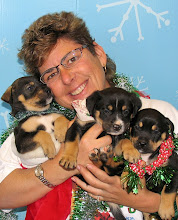These manifestations of our changing society are increasing in number throughout the country. They are usually well lit to accommodate early morning and evening visits, segmented into areas for dogs of different sizes, and offer both poop pickup and water stations. While the concept seems idyllic, there are frequently issues that arise which can turn fur-filled frolic into a doggone bad experience for four-legged and two-legged alike. Bark Park visitors can help keep it happy, safe and sane by following --- and reminding others about --- these simple but important “rules” of Bark Park etiquette:
- Be realistic about your dog’s personality and behavior. Bark Parks are not testing grounds to see IF your dog is social, or for him to “get over” a bad experience. Aggressive, anti-social, and toy-possessive dogs are not appropriate visitors; neither are unsprayed females in season.
- All playing pooches should understand and respond to basic verbal obedience commands, especially “come”, “stay” and “no”.
- No doubt that Bark Parks have become enjoyable social opportunities for humankind as well, but an owner’s primary responsibility is to make sure that his or her dog is behaving appropriately. Keep an eye on, and control the actions of, your dog. Excessively rough play, overt dominance posturing or deep-throated growling is not acceptable even if you are convinced that your dog “doesn’t mean anything by it”. And, just as importantly, only bring as many dogs as you can realistically handle.
- It is inappropriate and unacceptable for anyone to leave a dog at the Park and come back for him later (for those of you squinting in disbelief, this really does happen… far too often).
- Make sure your dog is healthy and up-to-date on vaccinations. While fun for fur kids, nose-to-nose contact, nose-to-butt introductions, and the sharing of water bowls and toys are potential breeding grounds for upper respiratory infections, viral mouth warts, and parasites.
- If a particular dog is causing a problem, politely ask the owner to leave; if he or she won’t comply, don’t stand on ceremony… have your dog say good-bye to his poochy playmates and end that day’s visit.
- Leave the park the way you found it. Most Bark Parks are not supervised or maintained by their city or municipality, so it is up to visitors to keep them clean and desirable to visit. All too often, visitors go home with a souvenir or two on the bottom of their shoes… or paws. Bring your own poop bags just in case the park has run out. Pick up all solid wastes and dispose of them in designated containers. And if you managed to dodge a land mine or two, be courteous and pick them up too!

